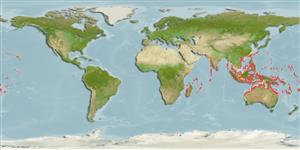Environment: milieu / climate zone / depth range / distribution range
Ecologia
marinhas associadas(os) a recifes; intervalo de profundidade 0 - 30 m (Ref. 5213). Tropical; 29°N - 34°S, 28°E - 157°W (Ref. 5222)
Indo-West Pacific: Natal, South Africa to the central Pacific. Not known from the Red Sea nor Persian Gulf.
Tamanho / Peso / Idade
Maturity: Lm ? range ? - ? cm
Max length : 54.9 cm TL macho/indeterminado; (Ref. 125599); common length : 25.0 cm TL macho/indeterminado; (Ref. 9137); peso máx. publicado: 3.8 kg (Ref. 125599)
Espinhos dorsais (total) : 11; Raios dorsais (total) : 14 - 16; Espinhos anais: 3; Raios anais : 8. A single large black blotch along middle of dorsal fin base (Ref. 37816), which can be turned off (Ref. 48635); further characterized by head, body and fins having numerous close-set polygon shaped dark brown spots; broad zone along side of body with ctenoid scales, cycloid scales elsewhere; body with auxiliary scales; greatest depth of body 2.9-3.4 in SL; rounded caudal fin; short pelvic fins, 2.0-2.6 in head length (Ref. 90102); head length 2.2-2.4 in SL; flat or slightly concave interorbital area; rounded preopercle, serrae mostly covered by skin; straight or slightly convex upper edge of operculum; subequal posterior and anterior nostrils; maxilla reaches to or past vertical at rear edge of eye; 3-5 rows of teeth on midlateral part of lower jaw, inner teeth about twice as long as outer ones (Ref. 89707).
Occur in outer reef flats and shallow lagoon (Ref. 37816). Reported to be taken in a trawl, thus presumably caught somewhat deeper than 7 m. Also reported to occur in reefs at a depth of about 30 m (Ref. 5213). Because of its small size and apparent rarity, it is of little or no commercial importance. Solitary (Ref 90102).
Ciclo de vida ou comportamento de acasalamento
Maturidade | Reprodução | Desova | Ovos | Fecundidade | Larvas
Heemstra, P.C. and J.E. Randall, 1993. FAO Species Catalogue. Vol. 16. Groupers of the world (family Serranidae, subfamily Epinephelinae). An annotated and illustrated catalogue of the grouper, rockcod, hind, coral grouper and lyretail species known to date. Rome: FAO. FAO Fish. Synop. 125(16):382 p. (Ref. 5222)
Status na Lista Vermelha da UICN (Ref. 130435: Version 2024-2)
Ameaça para os humanos
Reports of ciguatera poisoning (Ref. 31637)
Uso pelos humanos
Pescarias: pesca de subsistência
Ferramentas
Relatórios especiais
Baixar XML
Fontes da internet
Estimates based on models
Preferred temperature (Ref.
123201): 24.9 - 29.3, mean 28.4 °C (based on 2734 cells).
Índice de diversidade filogenética (Ref.
82804): PD
50 = 0.5000 [Uniqueness, from 0.5 = low to 2.0 = high].
Bayesian length-weight: a=0.01175 (0.00681 - 0.02028), b=3.05 (2.91 - 3.19), in cm total length, based on LWR estimates for this species & Genus-body shape (Ref.
93245).
Nível Trófico (Ref.
69278): 4.0 ±0.67 se; based on food items.
Resiliência (Ref.
120179): médio(a), tempo mínimo de duplicação da população 1,4 - 4,4 anos (Preliminary K or Fecundity.).
Fishing Vulnerability (Ref.
59153): Moderate vulnerability (42 of 100).
Nutrients (Ref.
124155): Calcium = 37.4 [18.0, 75.7] mg/100g; Iron = 0.522 [0.288, 1.088] mg/100g; Protein = 18.5 [17.0, 19.9] %; Omega3 = 0.125 [0.079, 0.199] g/100g; Selenium = 27 [16, 48] μg/100g; VitaminA = 232 [64, 837] μg/100g; Zinc = 1.42 [0.97, 1.99] mg/100g (wet weight);
